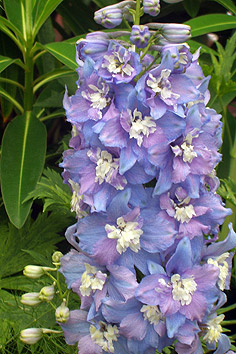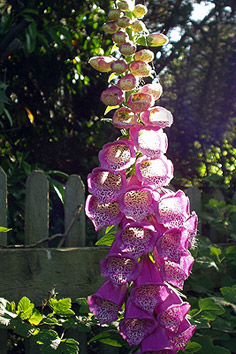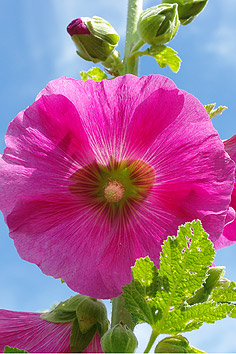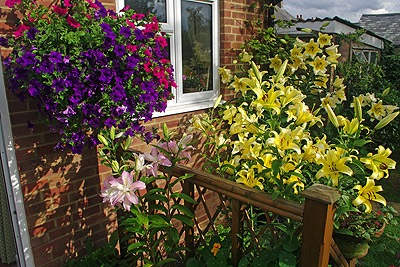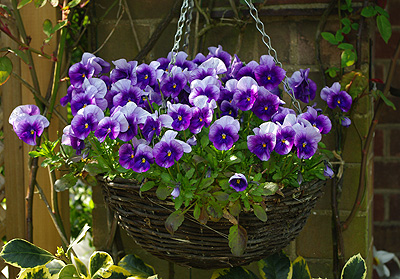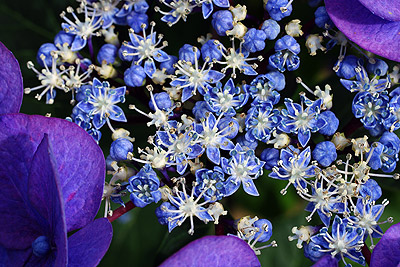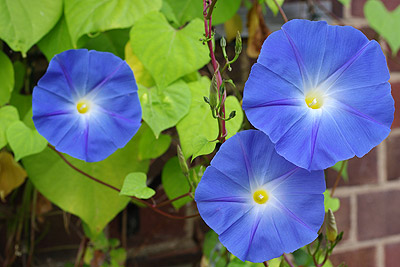The Garden in July - Jobs and Tips
plants for July
Jobs / Tips
![]() Time to plant some spectacular and easy summer flowering perennials
from seed. These are three garden plants that are so easy
to grow from seed that I wonder why anybody ever goes to buy
them from a garden centre. These are;
Time to plant some spectacular and easy summer flowering perennials
from seed. These are three garden plants that are so easy
to grow from seed that I wonder why anybody ever goes to buy
them from a garden centre. These are;
And now is the time to buy the seeds. Sow them in a seed tray in a sheltered part of the garden but out of direct sunshine, keep the compost moist and they can't fail to germinate. Prick them out 15 (3 x 5) in a seed tray and then eventually into 1L pots and then come the autumn, for a minimal cost per packet of seed you can have dozens (if you look after them all) of plants that will cost at least a fiver each down at the garden centre come the autumn.
They really are the easiest of perennials to grow and if you've never grown anything from seed before, this should encourage you to more victories to come.
![]() Prepare container plants for some neglect if you're going on
holiday. Try to get someone to call round and give your
plants some attention when you're away or the chances are that
your lovingly prepared containers in particular may be full
of dead or half dead plants on your return. Before you go place
your containers in a shady part of the garden, in a place that
is light, but receives as little direct sunlight as possible
- not under the leaf canopy of trees. Baskets can be placed
on large plants pots to keep them stable. Try to get your helper
to water them thoroughly at least once every 3 days. Don't worry
about feeding or deadheading (I've had emails of disasters inflicted
by enthusiastic but unknowledgeable friends). If you have any
tomatoes, peppers or similar that might produce fruit while
you're gone, let them have these as they ripen, it will encourage
them to visit and it's better for the plant to have ripe fruit
removed regularly. Place a watering can or hosepipe in easy
reach, in fact you could just leave a hose uncoiled for easy
access - make it easy for people to help you. Don't forget
to bring a stick of rock or a sombrero back as a reward.
Prepare container plants for some neglect if you're going on
holiday. Try to get someone to call round and give your
plants some attention when you're away or the chances are that
your lovingly prepared containers in particular may be full
of dead or half dead plants on your return. Before you go place
your containers in a shady part of the garden, in a place that
is light, but receives as little direct sunlight as possible
- not under the leaf canopy of trees. Baskets can be placed
on large plants pots to keep them stable. Try to get your helper
to water them thoroughly at least once every 3 days. Don't worry
about feeding or deadheading (I've had emails of disasters inflicted
by enthusiastic but unknowledgeable friends). If you have any
tomatoes, peppers or similar that might produce fruit while
you're gone, let them have these as they ripen, it will encourage
them to visit and it's better for the plant to have ripe fruit
removed regularly. Place a watering can or hosepipe in easy
reach, in fact you could just leave a hose uncoiled for easy
access - make it easy for people to help you. Don't forget
to bring a stick of rock or a sombrero back as a reward.
![]() Buy a pot of your favourite herbs from the supermarket and keep
them going all summer long. Get one of the pots that are
overstuffed with plants, take a quarter of the original clump
and split it again into 2,3 or 4 and put the new small clumps
at the edges of a new pot the same size as the original. Place
the new pots in a sunny protected place and don't pick for a
while. When you do start to pick the leaves, do just that -
pick the leaves not the stems. Pinch out any flower buds that
appear and this will encourage the plants to make more side
shoots of leaves for your salads and cookery. In fact buy two
pots, one to propagate from and one to use while the others
are growing.
Buy a pot of your favourite herbs from the supermarket and keep
them going all summer long. Get one of the pots that are
overstuffed with plants, take a quarter of the original clump
and split it again into 2,3 or 4 and put the new small clumps
at the edges of a new pot the same size as the original. Place
the new pots in a sunny protected place and don't pick for a
while. When you do start to pick the leaves, do just that -
pick the leaves not the stems. Pinch out any flower buds that
appear and this will encourage the plants to make more side
shoots of leaves for your salads and cookery. In fact buy two
pots, one to propagate from and one to use while the others
are growing.
![]() Sow seeds of winter flowering
pansies and violas. These
are also amongst the easier plants to grow from seed and if
started off now will be good strong plants by the autumn and
so able to flower throughout the winter period finishing off
with a final flourish in the spring. Both are strictly speaking
perennials and can be kept going, but they are never again as
good as they were in the first, so are best discarded and replaced.
One of the main reasons I grow from seed rather than buying
them as plants is that you can get a group of all your favourite
shades and colours, particularly effective in containers if
all of one colour. If unsure go for violas, smaller prettier
flowers, often more vigorous and tougher over the winter.
Sow seeds of winter flowering
pansies and violas. These
are also amongst the easier plants to grow from seed and if
started off now will be good strong plants by the autumn and
so able to flower throughout the winter period finishing off
with a final flourish in the spring. Both are strictly speaking
perennials and can be kept going, but they are never again as
good as they were in the first, so are best discarded and replaced.
One of the main reasons I grow from seed rather than buying
them as plants is that you can get a group of all your favourite
shades and colours, particularly effective in containers if
all of one colour. If unsure go for violas, smaller prettier
flowers, often more vigorous and tougher over the winter.
![]() A good time to take softwood cuttings of shrubs. Cut a piece
of new stem about 6 inches long and remove all flower buds and
all but the end 3 or 4 leaves. Place several of these around
the rim of a small plant pot filled with a mixture of sand and
compost. Water and place in a shaded place, don't allow to dry
out. Check the bottom of the pot after a month or so and pot
up individual cuttings when you see roots sticking through the
drainage holes.
A good time to take softwood cuttings of shrubs. Cut a piece
of new stem about 6 inches long and remove all flower buds and
all but the end 3 or 4 leaves. Place several of these around
the rim of a small plant pot filled with a mixture of sand and
compost. Water and place in a shaded place, don't allow to dry
out. Check the bottom of the pot after a month or so and pot
up individual cuttings when you see roots sticking through the
drainage holes.
I always feel that it's worth trying almost any plant by this method. Even when I read up how to propagate a particular plant I usually try this method as well anyway. It's so simple, it's done at a time of the year when it is warm and you're often out in the garden, and cuttings are frequently plentiful from prunings so it's no disaster if they don't take.
![]() Shrubs and climbers can be layered now. A technique that
works with many varieties and is often successful with the more
difficult plants. A fairly young shoot is brought down to ground
level and a part of the stem buried about an inch or two deep
with a small mound of soil on top, it may be necessary to peg
particularly whippy shoots with a small wire hoop. Then that's
it, it will take longer to root than in other methods, but scores
in that there's no need to look after the cutting as the parent
plant makes sure that it's kept alive. Best left for 6 months
to a year before detaching and planting or potting up separately.
Shrubs and climbers can be layered now. A technique that
works with many varieties and is often successful with the more
difficult plants. A fairly young shoot is brought down to ground
level and a part of the stem buried about an inch or two deep
with a small mound of soil on top, it may be necessary to peg
particularly whippy shoots with a small wire hoop. Then that's
it, it will take longer to root than in other methods, but scores
in that there's no need to look after the cutting as the parent
plant makes sure that it's kept alive. Best left for 6 months
to a year before detaching and planting or potting up separately.
![]() Keep watering and
feeding containers regularly. It's so sad
when they are neglected and what began as a vibrant collection
of flowers dies slowly over a week or even a few days for lack
or regular attention. Contrary to popular belief containers
are not a low-maintenance option, far from it.
Keep watering and
feeding containers regularly. It's so sad
when they are neglected and what began as a vibrant collection
of flowers dies slowly over a week or even a few days for lack
or regular attention. Contrary to popular belief containers
are not a low-maintenance option, far from it.
Checked them daily particularly if there's a drying wind which can suck all of the water out of a container in a few hours. When planting up any containers, always go for the largest you can afford so they don't dry out so quickly. Water, feed and dead-head regularly for the best show.
![]() Keep dead-heading perennials and shrubs such as roses.
This keeps them producing more flowers rather than putting
their energy's into seed and fruit production.
Keep dead-heading perennials and shrubs such as roses.
This keeps them producing more flowers rather than putting
their energy's into seed and fruit production.
![]() Water autumn and spring planted trees and shrubs during
hot dry spells. If you "baby" trees and shrubs through their
first summer, them you're usually fine from then on. Give them
an occasional thorough soaking though rather than a daily drizzle
is better.
Water autumn and spring planted trees and shrubs during
hot dry spells. If you "baby" trees and shrubs through their
first summer, them you're usually fine from then on. Give them
an occasional thorough soaking though rather than a daily drizzle
is better.
![]() Look for "suckers" on roses or grafted trees.
Look for "suckers" on roses or grafted trees.
![]() Summer drought and heat - there are a number of
things you can do to help the garden
Summer drought and heat - there are a number of
things you can do to help the garden
- Set the lawnmower a notch or two higher than normal.
- Don't worry about the grass going yellow or even brown, it's a great survivor and should come back again when there's enough water.
- Water in the evening when there's less chance the water will be evaporated by the sun before the plants can get it.
- If you've planted any large perennials, shrubs or trees in the last year, they'll benefit from a little help through their first summer. Give them a full watering can or bucket (about 10 litres) each every now and then. Not more than once a week and a big deep drink. Little and often encourages surface roots and dependency.
- Get a water butt
![]() Have you got a water
butt? They
are just so convenient and useful. In the climate I live in,
the garden is watered from the sky and the butts filled at the
same time, 90% of the time, by the time the butt empties, the
sky does its bit again, dousing the garden and filling the butts
again for the next dry spell.
Have you got a water
butt? They
are just so convenient and useful. In the climate I live in,
the garden is watered from the sky and the butts filled at the
same time, 90% of the time, by the time the butt empties, the
sky does its bit again, dousing the garden and filling the butts
again for the next dry spell.
One not so good thing about water butts is the mosquitoes that can start to breed in the water. There's are two possible answers to this:
- Catch them by scooping up with a fine net and feed them to your aquarium fish
- Use cooking oil
I tried cooking oil for the first time last year and I'm pleased to announce it works splendidly. You pour some onto the top of the water in your butt and that's it, you could even use discarded oil from deep frying if you have it. As it floats on the surface, the oil prevents the larvae from reaching the air and so kills them, it also traps and kills adults that come down to lay eggs or larvae that trying to emerge. You don't even need to have a continuous layer, about 50% of the total area works just as well, it does start to rot down and turn very peculiar as it does so, but stays effective for around a month or more. I've not been able to gauge how long properly as rain meant that I lost a couple of applications in the overflow, but it has these commendations:
- It's cheap, any cooking oil floats, so the lowest priced budget brand does just as a good a job as any.
- It works really effectively.
- It's totally organic - well it's food isn't it? not a chemical as such.
- It doesn't seem to kill the rat-tailed maggots in the water butt - indulge me here - these are the ugly looking larval stages of a species of hoverfly, while I don't like the looks of them, I do admire their adaptation to where they live and I do like hoverflies.
The only downside is that you need to keep an eye on it and top it up every now and then if it rots away or gets washed down the overflow pipe. Only use the water from the butt for larger mature plants not seeds or seedlings, but that applies anyway - with or without oil.
Copyright 2000 - present. All Rights Reserved | Privacy Policy Statement

